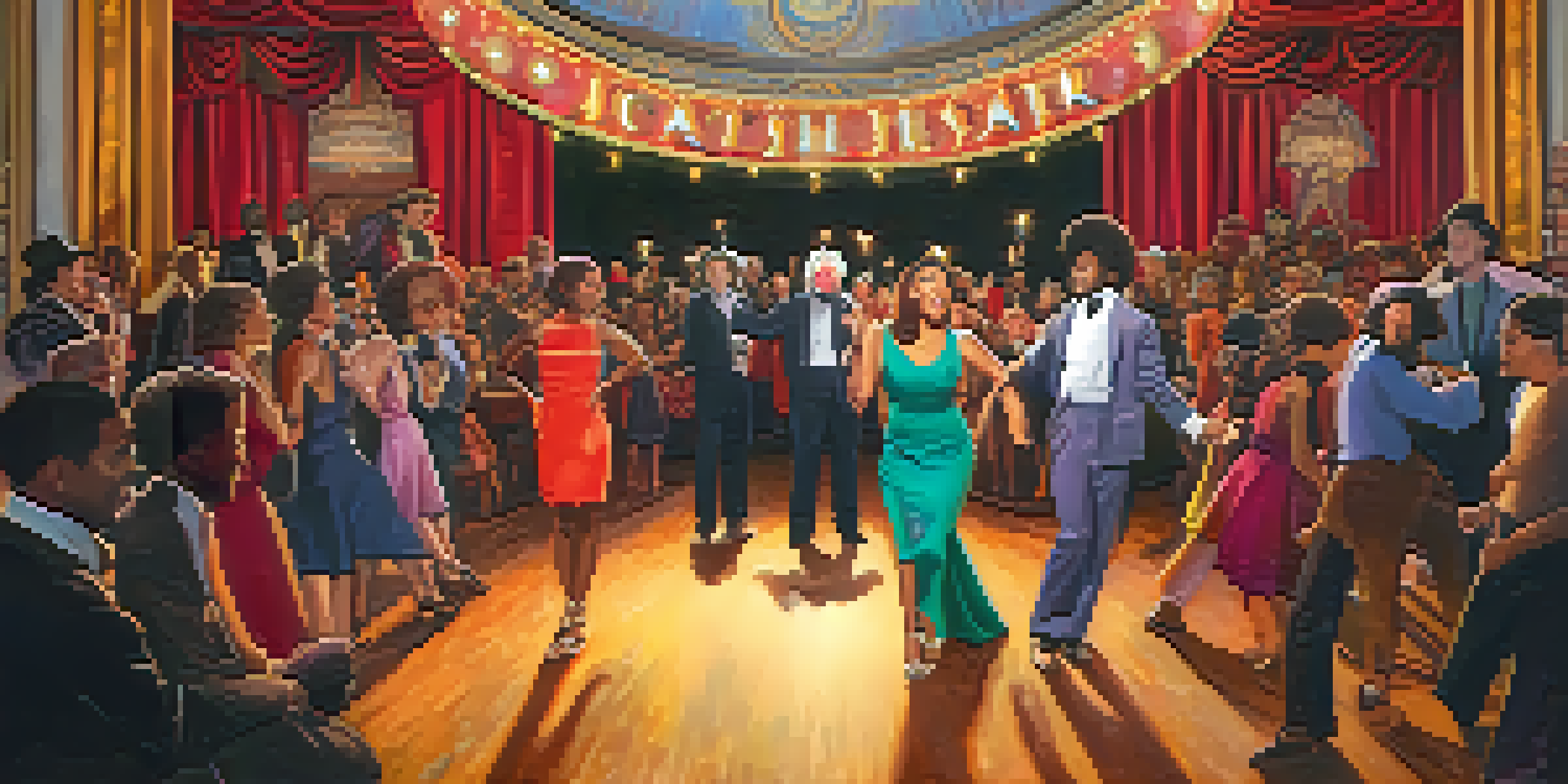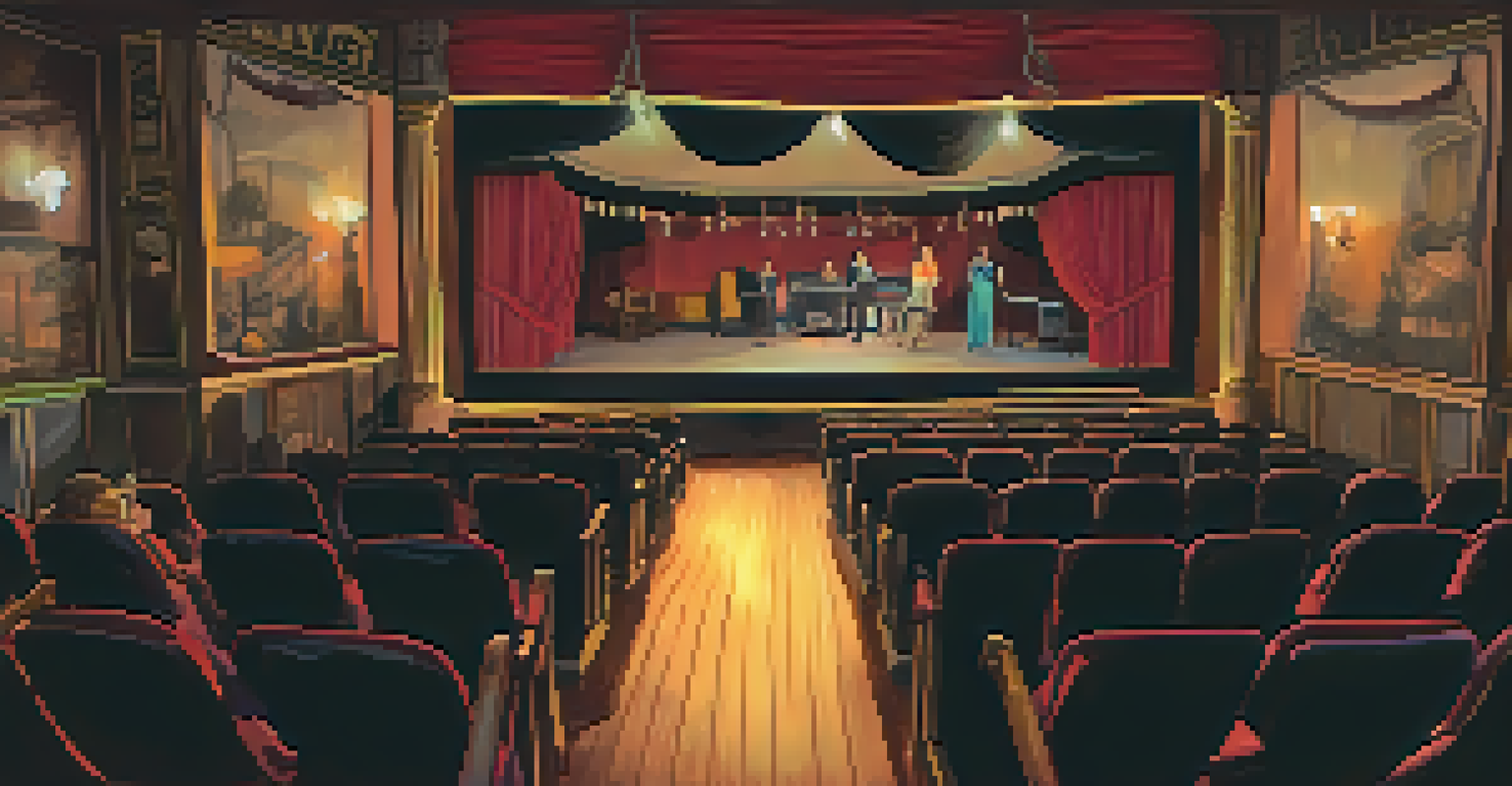The Evolution of Independent Theater in New York City

The Roots of Independent Theater in NYC
Independent theater in New York City has a rich history that dates back to the early 20th century. During this time, artists sought to escape the constraints of commercial theater, leading to the birth of avant-garde performances. Venues like the Provincetown Playhouse became hotbeds for new and experimental works, shaping a unique artistic identity.
The theater is a place where we can take a pause from our lives and reflect on the world we live in.
In the 1920s and 1930s, the rise of the Federal Theatre Project further fueled this movement, providing support and resources for innovative productions. This initiative encouraged playwrights and actors to explore social issues through their craft, making theater a platform for change. It was a time when the community rallied behind independent art, setting the stage for future generations.
As the decades progressed, the seeds sown by these early pioneers blossomed into a vibrant scene. The blending of various art forms, such as music and visual arts, began to emerge within independent theater, attracting diverse audiences. This spirit of collaboration and experimentation remains a hallmark of New York's indie theater landscape today.
The Rise of Off-Broadway and Its Impact
In the 1960s, the Off-Broadway movement gained momentum, providing a crucial platform for independent theater. Venues like the New York Theatre Workshop and the Public Theater emerged, showcasing groundbreaking works that challenged societal norms. This era marked a shift where smaller productions could rival the grandeur of Broadway.

Off-Broadway offered artists the freedom to experiment with form and content, often addressing underrepresented voices and stories. Productions like 'Hair' and 'A Chorus Line' broke barriers and redefined what theater could be, proving that powerful narratives could thrive outside the traditional commercial circuits. These shows not only entertained but also sparked conversations about culture and identity.
Independent Theater's Rich History
Independent theater in NYC has evolved from early 20th-century avant-garde performances to a vibrant scene that continues to thrive today.
The success of Off-Broadway paved the way for a new wave of independent theater companies. As audiences embraced these innovative works, artists found more opportunities to create and collaborate, enriching the overall landscape of New York's performing arts scene. This period solidified the importance of independent endeavors in shaping the future of theater.
The Influence of Cultural Movements
Throughout the decades, various cultural movements have significantly influenced independent theater in NYC. The feminist movement, for instance, brought attention to women playwrights and directors, showcasing their stories and perspectives. This led to a surge in productions that explored gender issues and challenged stereotypes.
Art is not a mirror held up to reality, but a hammer with which to shape it.
Similarly, the LGBTQ+ rights movement found its voice in independent theater. Companies like the WOW Café Theatre provided a safe space for queer artists to express themselves, leading to iconic plays that resonated with audiences. These movements not only shaped the narratives being told but also fostered community and solidarity among artists.
As these cultural shifts continued to evolve, independent theater adapted and reflected the changing societal landscape. Today, it remains a vibrant space for diverse voices, addressing contemporary issues while celebrating the rich tapestry of human experience. The ongoing dialogue between art and culture keeps the spirit of independent theater alive and relevant.
Technological Advances and Their Role
The advent of technology has transformed independent theater in ways that were unimaginable a few decades ago. From social media promotion to digital streaming, artists now have tools at their disposal to reach wider audiences. This accessibility has allowed smaller productions to gain visibility and traction, leveling the playing field.
Moreover, technology has influenced the way stories are told on stage. Innovative lighting, sound design, and multimedia elements have become integral parts of the theatrical experience. Independent theater companies are now able to push creative boundaries, creating immersive environments that captivate audiences and enhance storytelling.
Cultural Movements Shape Narratives
The feminist and LGBTQ+ rights movements have significantly influenced independent theater, fostering diverse storytelling and community solidarity.
As the landscape continues to shift, independent theater remains at the forefront of adopting new technologies. This willingness to embrace change not only attracts younger audiences but also encourages a fresh wave of creativity. The fusion of technology and theater enriches the art form, ensuring its evolution remains dynamic and relevant.
Challenges Faced by Independent Theater
Despite its rich history and cultural significance, independent theater in NYC faces numerous challenges. Funding remains a critical issue, as many companies rely on grants and donations to sustain their operations. The financial strain can limit artistic freedom, forcing artists to compromise their vision to secure resources.
Additionally, the competition for audience attention is fierce, especially with the rise of digital entertainment options. Independent theaters must find innovative ways to engage audiences and differentiate themselves from mainstream offerings. This requires a deep understanding of audience preferences and a willingness to adapt to changing trends.
Yet, these challenges often serve as catalysts for creativity. Many independent theater companies have developed unique marketing strategies and community engagement initiatives that foster loyalty and build a supportive audience base. The resilience of the independent theater scene illustrates its enduring importance in the cultural fabric of New York City.
The Role of Community in Independent Theater
Community plays a vital role in the success and sustainability of independent theater. Many companies thrive on the support of local audiences, who often feel a personal connection to the stories being told. This sense of ownership fosters a loyal following, turning casual attendees into passionate advocates for the arts.
Moreover, independent theaters often collaborate with local artists, schools, and organizations, creating a network of support that enriches the community. These partnerships not only provide resources but also encourage the exchange of ideas and creativity. The result is a vibrant ecosystem that nurtures talent and promotes artistic growth.
Challenges and Community Support
Despite facing funding and competition challenges, independent theaters rely on community support and innovative strategies to sustain their artistic vision.
As these theaters continue to engage with their communities, they contribute to the cultural landscape of New York City. By addressing local issues and celebrating diverse voices, independent theater becomes a reflection of the community itself. This symbiotic relationship ensures that both the art and the audience thrive together.
Looking Ahead: The Future of Independent Theater
As we look to the future, independent theater in New York City is poised for exciting developments. The ongoing commitment to inclusivity and diversity will continue to shape the narratives being told on stage. By amplifying underrepresented voices, theaters can create a more equitable space for storytelling.
Additionally, the integration of new technologies will likely play a significant role in how theater is produced and consumed. As artists experiment with virtual reality and online platforms, the boundaries of traditional theater will expand, reaching audiences far beyond the city. This evolution promises to keep the art form fresh and engaging.

Ultimately, the resilience and creativity of independent theater will ensure its place in the cultural landscape of New York City. As artists and audiences continue to forge connections, the independent theater scene will remain a vital force for innovation and expression, embodying the spirit of artistic freedom.